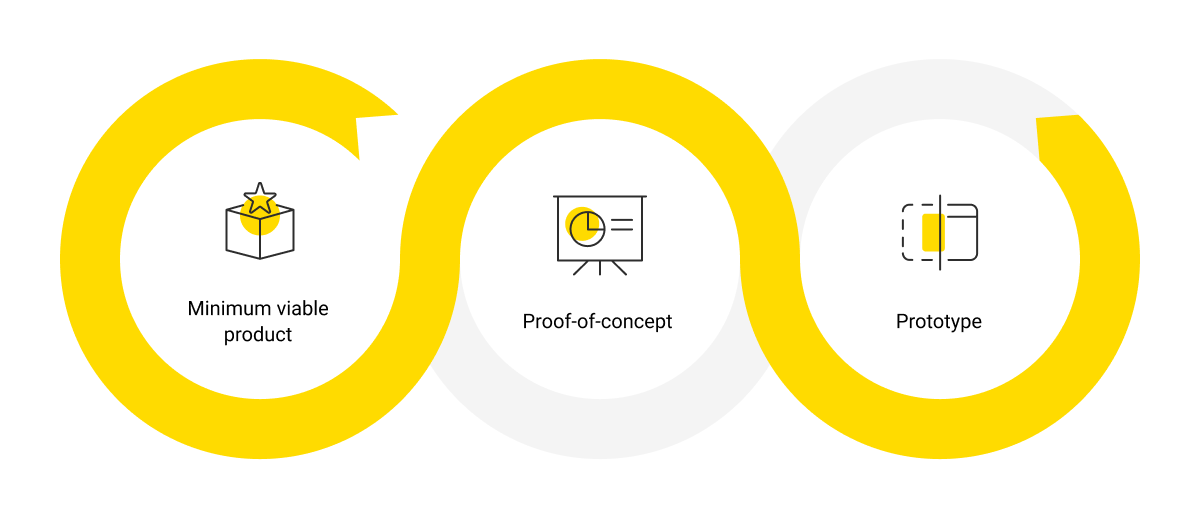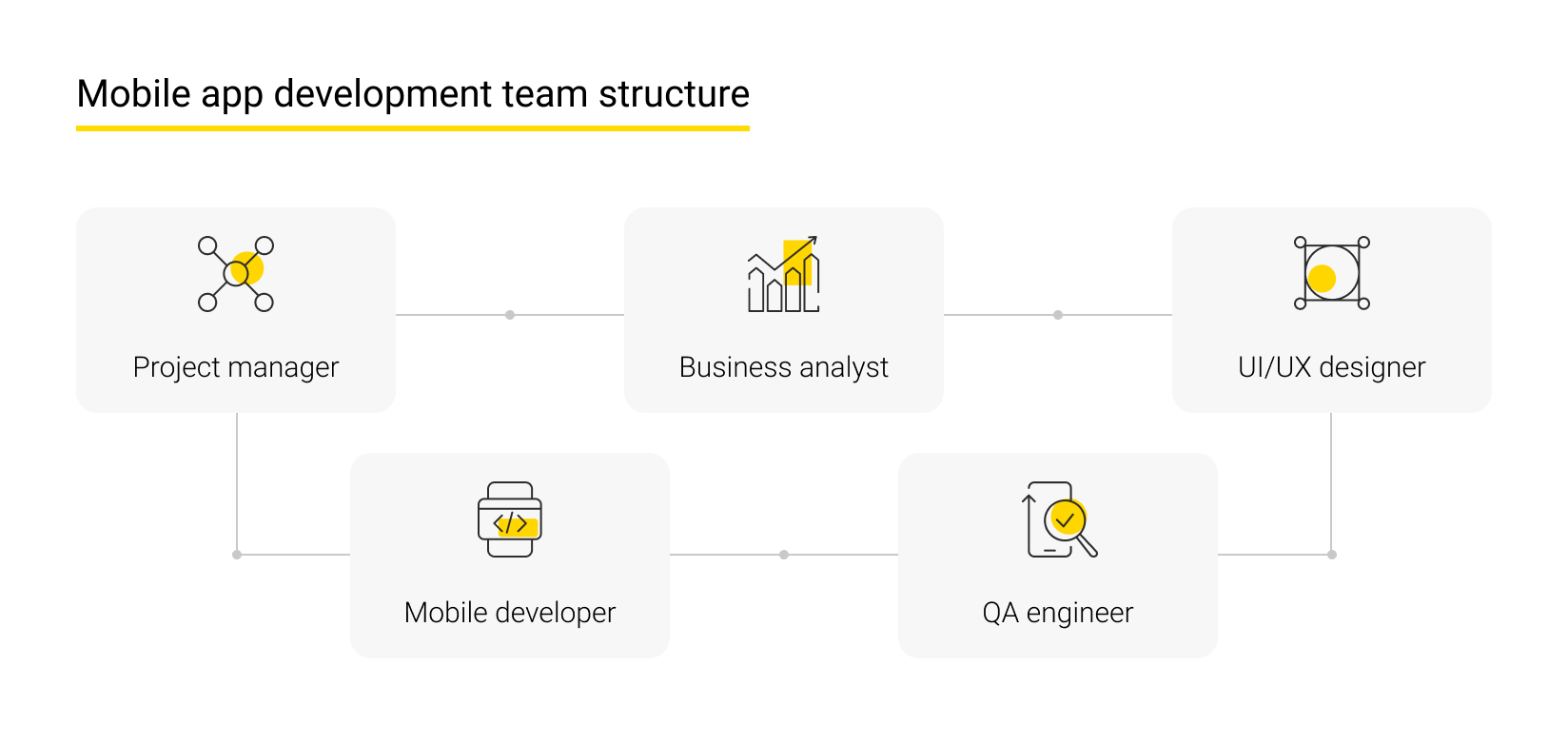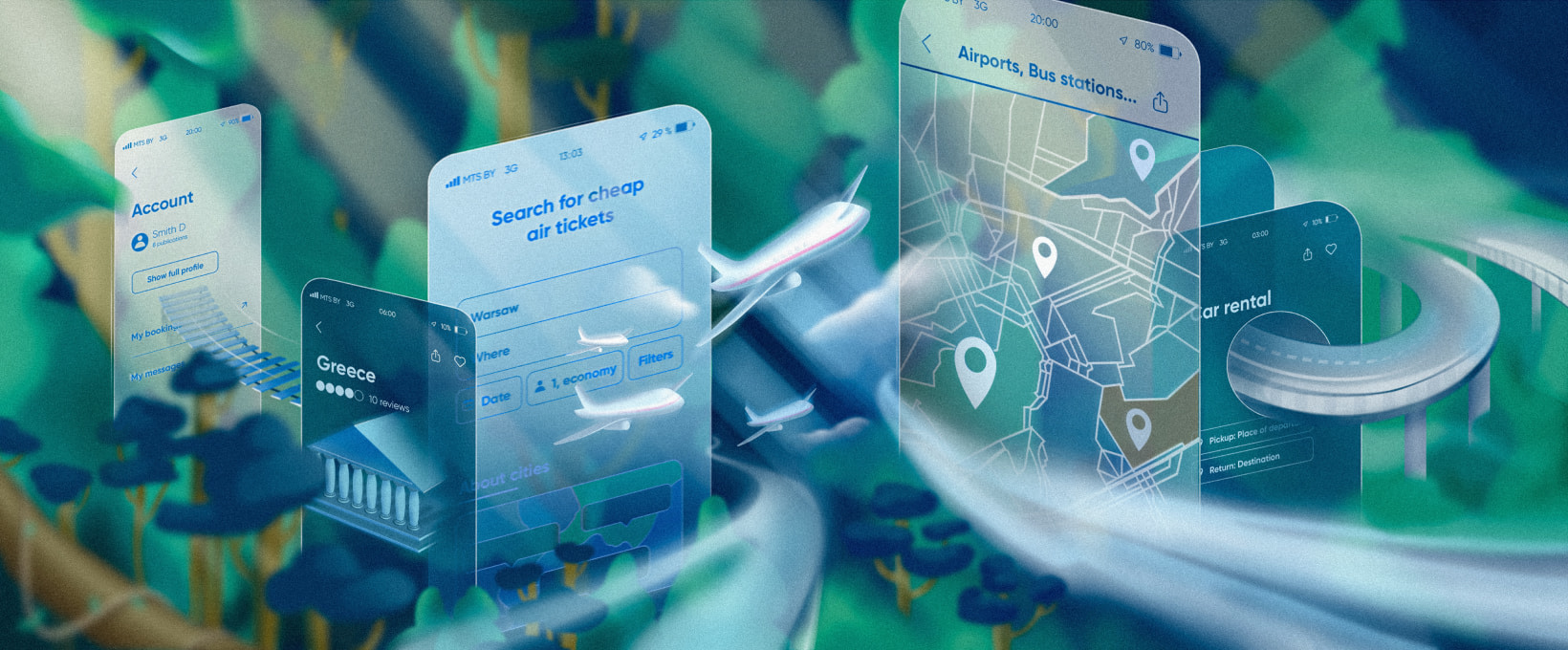- How long does it take to make an app, and why do you need one?
- The estimated mobile app development timeline explained
- Discovery phase
- App design and specifications
- Development
- Testing
- Support, maintenance, and upgrades
- How long does it take to build a mobile app? Key takeaways
A well-elaborated, complex app will serve as a fully-fledged and powerful engine for your company. It will help you capture new prospects, enhance client retention and strengthen their commitment, and amplify turnover. Nowadays, even non-tech startups at their nascent stages can afford this kind of solution. However, some organizations are still resistant to ordering one. Their primary question is this: “How long does it take to make an app?” They are concerned that the complexity of the app will lead to a protracted mobile app development timeline. In this piece, we’ll clarify some aspects regarding the general duration of various app development stages, taking into account that your goal is obtaining a stellar product without delay.
How long does it take to make an app, and why do you need one?
The following statistics confirm a self-evident truth — mobile app development benefits are compelling, even for non-technology organizations that want to build an app.
- According to Statista, the app market was projected to grow at an annual rate of 7.48% from 2022 to 2029, reaching a total revenue of $781.7 billion by the end of this period.
- Having a smartphone has become the norm. According to the Pew Research Center, in the US alone, 91% of individuals had a smartphone as of the end of 2024.
- According to the statistics provided by the International Telecommunication Union (ITU), as of 2024, there were a record 9.14 billion mobile phone subscriptions globally. Amazingly, this number exceeds the total world population.
- According to AppBrain, as of August 2025, the number of Google Play products for Android topped 1.5 million. Just three years ago, 3.5 million apps were presented on the platform. This notable decrease is associated with Google’s stringent policy of sifting out substandard apps that fail to demonstrate a sufficient level of testing. As a result, the remaining titles boast improved safety.
- According to Apple, its App Store currently offers around 2 million items, with users downloading or updating an impressive 5 billion app copies daily.
- As per the recent insights collected by TechJury, present-day touchscreen phones have, on average, 60 to 90 apps installed on them.
- As a rule, modern smartphone owners use approximately nine programs on a daily basis and up to 30 every month.
- A typical user spends several hours on their cell phone every day. Thus, in the UK, according to this year’s data by The Times, smartphone use among adults averages three hours and twenty-one minutes daily (hours and minutes spent talking on the phone are not included).
- The market share belonging to handheld devices is much more impressive than that of PCs. And it will continue to grow.
According to the statistics presented above, a mounting number of businesses are looking to develop an app to better perform their operations. Undoubtedly, there are various compelling reasons behind this trend. For instance, small company owners can stress the following perks of mobile development for their ventures:
- App development for small businesses contributes to “social integration”,
- They facilitate convenient payment methods,
- Entrepreneurs who leverage these capabilities are in a better position to communicate with their audiences,
- Finally, thanks to these programs, client loyalty rates are increased.
In other words, turning to a professional mobile app development company is advantageous. But how long would your mobile app development timeline be?
The estimated mobile app development timeline explained
So, how long does it take to make an app? On the one hand, the answer is obvious. Provided that your company is growing and thriving, the underlying work related to the design and development process will be perpetual. Ask yourself: how long do you need to build a city? Well, the truth is that flourishing cities never stop expanding and changing. The same principle governs the app development process. There will always be new upgrades, the desire to add state-of-the-art capabilities, and demands to satisfy, no matter whether you opted for an Android app, iOS app, hybrid solution, etc. On the other hand, there is still a typical estimate for your app development timeline. Generally, if you plan to create an app to offer your target audience a well-functioning tool with the most essential functionality, you should expect the time to build an app to take around six to nine months.
What is the logic behind this statement? Let us look at the details more closely. Briefly speaking, any app development process can be divided into five core stages.

Discovery phase
This phase encompasses translating your rough app idea into a coherent and feasible concept grounded on customer requirements, industry trends, and prominent benchmarks. It is one of the shortest stages and normally lasts up to four weeks.
During this relatively short period of time, business analysts perform critically important work that helps formulate the app’s scope and obtain a thorough understanding of its features. By relying on the insights from the customer, the specialists pinpoint user pain points and goals, outline user roles, and specify possible app vulnerabilities and limits. Based on this work, an extensive engineering roadmap with estimates can be drawn up.
As a result of these efforts, the customer receives:
- Carefully elicited, formulated, and documented requirements for the app. While executives fluently speak the language of business, they may find it challenging to explain to technology experts what exactly the solution they need is. Accomplished business analysts bridge business objectives with the technical side by explaining all the particularities in terms that the team can understand. These explanations can be found in the deliverables the customer receives, e.g., Software Requirements Specification, Vision and Scope, sketchy wireframes and polished prototypes, etc. What’s more, the experts validate the customer’s thoughts and plans against market and technology dynamics and come up with the fastest and most beneficial way to implement the project.
- Accurate estimates. Discovery eliminates the guesswork, providing the customer with a comprehensive specification of app features arranged by priority, with cost estimates and the average time to develop.
- A team of hand-picked specialists whose expertise precisely matches the scope and complexity of assignments.
One of the best things a mobile app development team can do at this point is to develop an uncluttered minimum viable product (MVP) serving as a prototype to test comprehensively and extensively. If you do so, your odds of quickly going through the subsequent app development stages and accelerating the app development time will be much higher.
We at Andersen fully realize the importance of this step and have gained substantial experience in building cross-functional MVPs. We prefer to keep them simple and avoid overcomplicating them with sophisticated UIs, various versions tailored to specific regions and nice-to-have but unnecessary bells and whistles. In other words, we embed just enough functionality to offer a solution to a core problem of the target audience and ensure that it’s effective and that the future fully-fledged app will pay off.
A scalable MVP is normally envisioned and realized in the course of the process that can be broken down as follows:
- Ideation. In the beginning, a foundational app concept is formulated. For this purpose, the team acquires fundamental insights to analyze them and use in app design by organizing brainstorming meetings, investigating the market, drafting representative user personas, and so on.
- Analysis. Based on the collected insights, the team prepares an exhaustive list of features essential for the MVP to fulfill its main purpose and get the concept behind the future fully-functional app validated.
- Product engineering and launch. The previously determined set of fundamental app elements is now being engineered, tested for seamless functioning, and launched. The resulting product is ready to use and yields concrete value.
- Work with feedback. This helps evaluate the perks and weak points of the app and decide on the further course of work to improve it. For this purpose, user involvement statistics are collected on sign-ups, active users, subscriptions, and more, and A/B testing is performed.
- Decision on the concept feasibility. Finally, the team and the customer make a decision on whether the fully-functional app will yield the expected ROI, and they’ll take the time to develop it.

App design and specifications
At this point, you have the visual style of your program crafted with its core UI/UX elements. Furthermore, a detailed list of features is drawn up, with performance scope and attributes. To design an app, you might need about four or five weeks.
Below are the key deliverables that are unique to this phase and aren’t provided at other stages:
- User journey,
- A list of functions together with the consumer needs these functions will meet,
- Visual appearance and brand identity – in other words, a comprehensive style guide,
- Documentation covering each of the features and the way your future platform is linked to your website,
- Project roadmap, i.e. a high-level plan that outlines the major goals, timeline and stages, the needed resources, expected deliverables, possible risks and mitigation strategies, as well as the channels and procedures for communicating the results to concerned parties.
Development
This is the coding work to launch your platform. Out of all the phases of app development, this is the most time-consuming one since it creates the digital architecture of your system. As our experience says, the average time to build an app may last up to six months.
In essence, it is grounded on two aspects of equal significance. The first one is the front-end, covering what your future audience will see. In the contemporary tech-driven world, one needs to be totally sure that the results are compatible with every popular browser, device, screen, and dimension. Hence, any actions taken concerning this part should be deliberate and thorough.
How many software engineers normally work on the front-end part? It depends on the industry and the complexity of the app. Sometimes, one developer is enough. However, for industries like iGaming, companies can employ dedicated specialists such as motion graphics engineers and well-versed developers who’d build engines handling the physics simulations for component interaction and motion.
Another crucial aspect is the back-end, as it ensures the seamless functioning of the app “behind the scenes.” It carries out the necessary communication with the back-end services over the network, performs the necessary updates based on newly generated app data, etc.
Most commonly, the connection with server-side services is established through diverse application programming interfaces, aka APIs. These are responsible for establishing a connection between different software programs to enable an uninterrupted exchange of information and capabilities between them. Thus, the entire engineering process can be substantially expedited, as developers can simply “borrow” the needed services, e.g. payments, maps, and authentication, from third parties rather than allocating time to creating them from square one.
Devising a robust integration strategy that provides for all necessary connections of your app with other systems, whether on-premises or cloud-based, e.g., those that manage inventory or customer relationships, plan enterprise resources, etc., and subsequently implementing the required APIs is one of the core services that a dependable software engineering company would provide.

Testing
This step is aimed at identifying potential issues in the app. In contrast with the rest of the stages, your core priority here is to thoroughly check your system as a whole. As with the discovery, this is one of the shortest stages with a timeline that encompasses roughly a month-long scope of work.
In spite of its short duration, this process includes thorough consideration of functional and non-functional requirements and drawing up an exhaustive test plan which explains testing coverage and deliverables, assignments and positions responsible for their execution, estimated timeframe, required programs and infrastructure, and test completion parameters.
Subsequently, specialists create well-structured, step-by-step test cases for various parts and behaviors of the app. Finally, they execute verifications manually or employ automated tools and draw up reports based on the findings. Additionally, proficient project managers regularly “scan” the code for errors and bugs during coding sprints.
Although not all customers consider this phase necessary, as it implies additional costs and time, omitting it is not recommended, as it ensures the following critical facets of the app are up to standard:
- Seamless performance on various devices, OSs, and their versions;
- Superb user experience, including easy-to-use menus, buttons, etc., flawless functionality in portrait and landscape orientations, and so on;
- Uninterrupted performance and optimal response speed, no matter traffic spikes or the need to scale;
- Robust security;
- Adherence to applicable regulations, e.g., WCAG, HIPAA, and others.
Support, maintenance, and upgrades
As we have previously pointed out, your solution will never be one hundred percent finalized. Markets never cease to change, technology never stops evolving, and sadly, new cybersecurity threats never stop emerging.
As a result, even if you feel satisfied with what you are about to launch, there is no guarantee that these deliverables will stay adequate and competitive in a year. Therefore, regular updates and professional maintenance of your product are actually some of the most valuable tips when you build an app, including the incorporation of cybersecurity advancements and user feedback to revamp it so that it continues bringing value to consumers.
As a rule, reliable software companies offer the following four types of maintenance, combining them as the need arises:
- Corrective approach: Bugs in the interface layout, source code, or overall logic are fixed as and when they occur;
- Adaptive approach: The app is tweaked to guarantee it keeps pace with new operating system releases and hardware improvements;
- Preventive approach: Scheduled refactoring and documentation revisions help to detect and handle any potential issues in a timely manner;
- Perfective approach: The source code is revised according to feedback from users to refine and enrich their experience.
The scope of these services varies and depends on the scale and complexity of apps. Those with simple, standard features have no need for more than routine bug fixes and insignificant refinements to keep them updated with new OS releases. Conversely, convoluted, enterprise-scale programs for banking, logistics, retail, etc., which involve sophisticated back-end and technology like AI, data mapping, and so on, require periodic performance and security audits and scalability optimizations for the server side.
How long does it take to build a mobile app? Key takeaways
As you can see, there is nothing impossible in obtaining a well-functioning solution for your business, especially if it’s a simple app that will meet your needs. Yes, it will take time to make an app – probably, its timeline will be more extended than you suppose right now. However, going through all its stages is still a short-term challenge you can handle with the support of a carefully chosen app developer with the requisite skills and experience.
Our team of well-versed experts welcomes you to discover for yourself the potential of Andersen in custom mobile development. On our site, we offer a calculator that enables you to obtain app development cost and timeline estimates and start crafting your tailor-fit app as soon as possible. Whether it is an uncomplicated cross-platform MVP or a convoluted system with vast amounts of data and impeccable security, it will be delivered on time.




